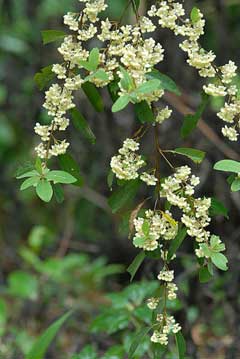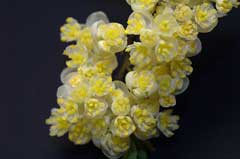 |
|
http://www.flickr.com/photos/plj/ |
 |
| http://www.flickr.com/photos/mutolisp/ |
Translate this page:
Summary
Physical Characteristics

 Litsea cubeba is a deciduous Shrub growing to 7 m (23ft). It is in flower from March to April, and the seeds ripen from August to September. The species is hermaphrodite (has both male and female organs).
Litsea cubeba is a deciduous Shrub growing to 7 m (23ft). It is in flower from March to April, and the seeds ripen from August to September. The species is hermaphrodite (has both male and female organs).
Suitable for: light (sandy), medium (loamy) and heavy (clay) soils. Suitable pH: mildly acid, neutral and basic (mildly alkaline) soils. It can grow in semi-shade (light woodland) or no shade. It prefers moist soil.
UK Hardiness Map
US Hardiness Map
Synonyms
Plant Habitats
Woodland Garden Sunny Edge;
Edible Uses
Edible Parts: Fruit Oil Root
Edible Uses: Condiment Oil Tea
The fragrant flowers are eaten or used as a flavouring for tea[301
, 310
, 317
].
The fruits are eaten as a vegetable side dish, and are a common substitute for cubeb pepper (Piper cubeba)[301
, 310
, 317
].
The fruit, bark and leaves are often used by the Karen people of N. Thailand as a curry ingredient in a dish called 'Kaeng Nuea'[931
].
The roots are cooked as a flavouring in foods[301
].
References More on Edible Uses
Medicinal Uses
Plants For A Future can not take any responsibility for any adverse effects from the use of plants. Always seek advice from a professional before using a plant medicinally.
Antiphlogistic Expectorant Parasiticide
Antiphlogistic, expectorant[147]. The root, stem, leaves and fruits are all used as medicine for eliminating windevil and dispelling the cold in the body, allaying swelling and pain[266]. The fruit is used as medicine is known as 'Bi Cheng Qie'[266].
References More on Medicinal Uses
The Bookshop: Edible Plant Books
Our Latest books on Perennial Plants For Food Forests and Permaculture Gardens in paperback or digital formats.

Edible Tropical Plants
Food Forest Plants for Hotter Conditions: 250+ Plants For Tropical Food Forests & Permaculture Gardens.
More

Edible Temperate Plants
Plants for Your Food Forest: 500 Plants for Temperate Food Forests & Permaculture Gardens.
More

More Books
PFAF have eight books available in paperback and digital formats. Browse the shop for more information.
Shop Now
Other Uses
Cosmetic Essential Furniture Oil Parasiticide Pioneer Shelterbelt Wood
Agroforestry Uses:
Grown as a shade tree in plantations[317
]. It is planted as a wind-break in tea plantations[310
].
A fast-growing pioneer species, usually gregarious in open areas, is found along the edge of tropical rain forests and the edges of both lower and upper montane forests[931
]. It can be used at the early stages in reforestation projects, and would make a good choice when establishing a woodland garden[K
].
The tree is planted as a pioneer species in northern Thailand in reforestation projects to restore native woodland - it is planted in degraded woodland and open areas in a mix with various other species that all have the ability to grow fast; produce dense, weed-suppressing crowns; and attract seed-dispersing wildlife, particularly birds and bats[998
].
Other Uses:
The flowers, leaves, and fruit walls are all sources of essential oils[266
, 317
]. These oils are processed for citral and are also used for their fragrance and medicinal properties[266
, 317
]. Citral is used for the production of ionones and formerly vitamin A and in essences for cosmetics, foodstuffs and tobacco products[310
]. Because of its pleasant citrus-like smell and taste it is a modifier for lemon and lime flavours and a general freshener in fruit flavours[310
]
The main essential oil, known as 'may-chang oil' is obtained from the fruit[310
]. (Though one report says it is obtained from the flowers[317
].) This oil is used in perfumery and is also the main source of citral, for which it is commercially cultivated[310
]. In perfumery, may chang oil is used as an alternative for verbena oil and lemongrass oil in colognes, household sprays, soaps and air-fresheners[310
].
An extract of the fruit is used as an ingredient in commercial cosmetic preparations as a perfume[1243
].
The essential oil obtained from the fruit is used as an ingredient in commercial cosmetic preparations as a masking agent and perfume[1243
].
An extract of the leaves is used as an ingredient in commercial cosmetic preparations as an antioxidant[1243
].
The seed contains a fatty oil, from which lauric acid and capric acid are produced[310
].
The wood is used for general furniture-making and construction[266
].
Special Uses
Attracts Wildlife Scented Plants
References More on Other Uses
Cultivation details
A fast-growing tree[998
].
Trees produced from cuttings can commence bearing fruit when just 2 - 3 years old[310
].
All parts of the plant have a pleasant, lemon-like aroma[301
, 443
].
A dioecious species, both male and female forms need to be grown if seed is required[443
]. There are also forms of the plant with functioning hermaphrodite flowers[1025
]. We have very little information on this species and do not know if it will be hardy in Britain. However, judging by its native range, it could succeed outdoors at least in the milder areas of the country. The following notes are based on the general needs of the genus.
References Carbon Farming Information and Carbon Sequestration Information
Temperature Converter
Type a value in the Celsius field to convert the value to Fahrenheit:
Fahrenheit:
The PFAF Bookshop
Plants For A Future have a number of books available in paperback and digital form. Book titles include Edible Plants, Edible Perennials, Edible Trees,Edible Shrubs, Woodland Gardening, and Temperate Food Forest Plants. Our new book is Food Forest Plants For Hotter Conditions (Tropical and Sub-Tropical).
Shop Now
Plant Propagation
Seed -
Other Names
If available other names are mentioned here
Litsea, Dieng-si-sing, Earking, Entsurem, Jayar, Mang tang, Mejankeri, Ser-nam, Sernam, Shan ji jiao, Siltimur, Siqbil, Tanghaercherkung, Terhilsok, Zeng-jil,
Native Range
TEMPERATE ASIA: China (Anhui Sheng, Fujian Sheng, Guangdong Sheng, Guangxi Zhuangzu Zizhiqu, Guizhou Sheng, Hainan Sheng, Hubei Sheng, Hunan Sheng, Jiangsu Sheng, Jiangxi Sheng, Sichuan Sheng, Xizang Zizhiqu, Yunnan Sheng, Zhejiang Sheng), Japan (Honshu, Kyushu, Ryukyu Islands), Taiwan TROPICAL ASIA: Bangladesh, Bhutan, India (Sikkim), Nepal, Cambodia, Laos, Myanmar, Thailand, Vietnam, Indonesia (Jawa, Kalimantan, Sumatera), Malaysia
Weed Potential
Right plant wrong place. We are currently updating this section.
Please note that a plant may be invasive in one area but may not in your area so it's worth checking.
Conservation Status
IUCN Red List of Threatened Plants Status : This taxon has not yet been assessed

Growth: S = slow M = medium F = fast. Soil: L = light (sandy) M = medium H = heavy (clay). pH: A = acid N = neutral B = basic (alkaline). Shade: F = full shade S = semi-shade N = no shade. Moisture: D = dry M = Moist We = wet Wa = water.
Now available:
Food Forest Plants for Mediterranean Conditions
350+ Perennial Plants For Mediterranean and Drier Food Forests and Permaculture Gardens.
[Paperback and eBook]
This is the third in Plants For A Future's series of plant guides for food forests tailored to
specific climate zones. Following volumes on temperate and tropical ecosystems, this book focuses
on species suited to Mediterranean conditions—regions with hot, dry summers and cool, wet winters,
often facing the added challenge of climate change.
Read More
Expert comment
Author
(Lour.)Pers.
Botanical References
266
Links / References
For a list of references used on this page please go here
A special thanks to Ken Fern for some of the information used on this page.
Readers comment
© 2010, Plants For A Future. Plants For A Future is a charitable company limited by guarantee, registered in England and Wales. Charity No. 1057719, Company No. 3204567.